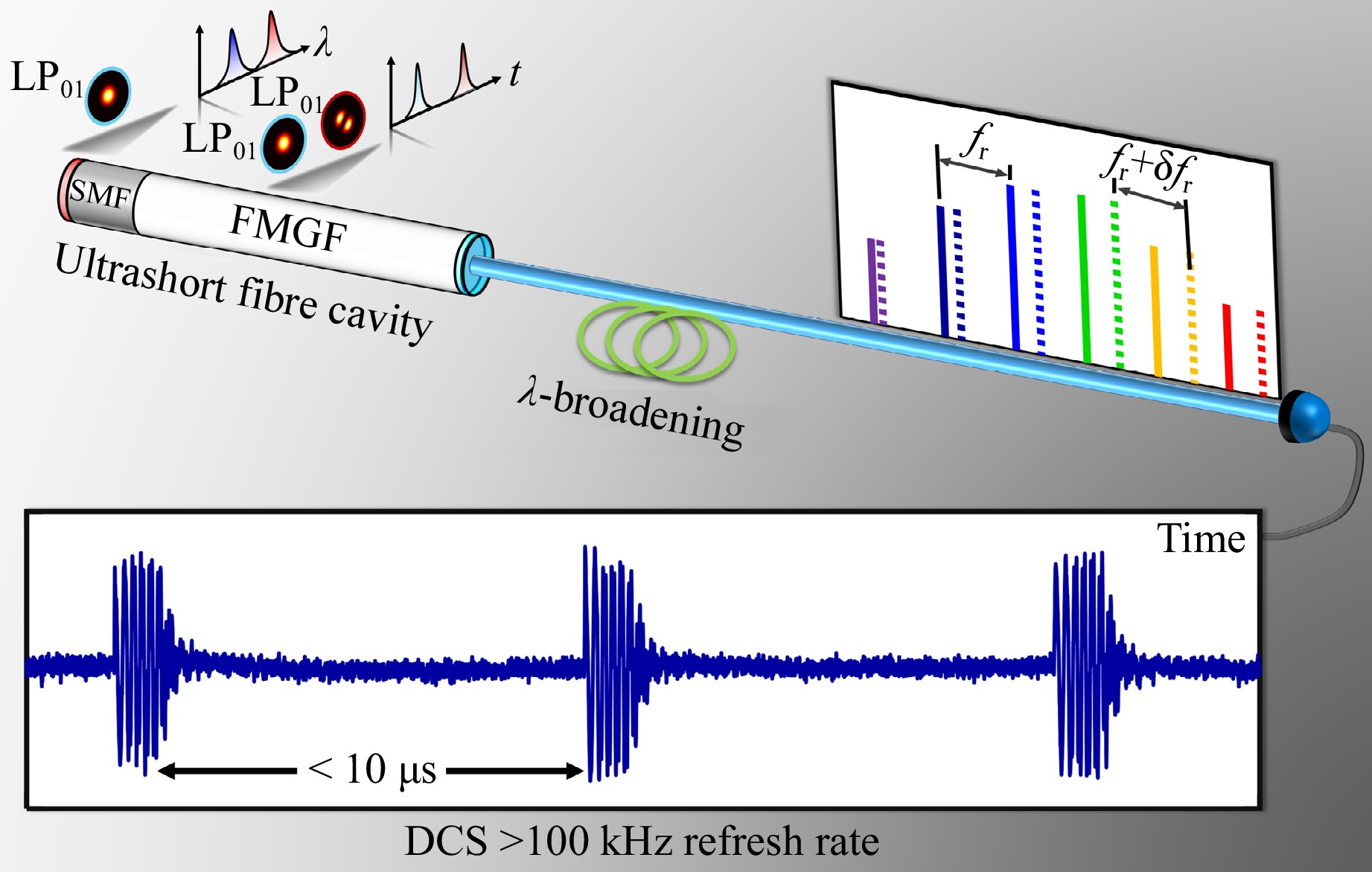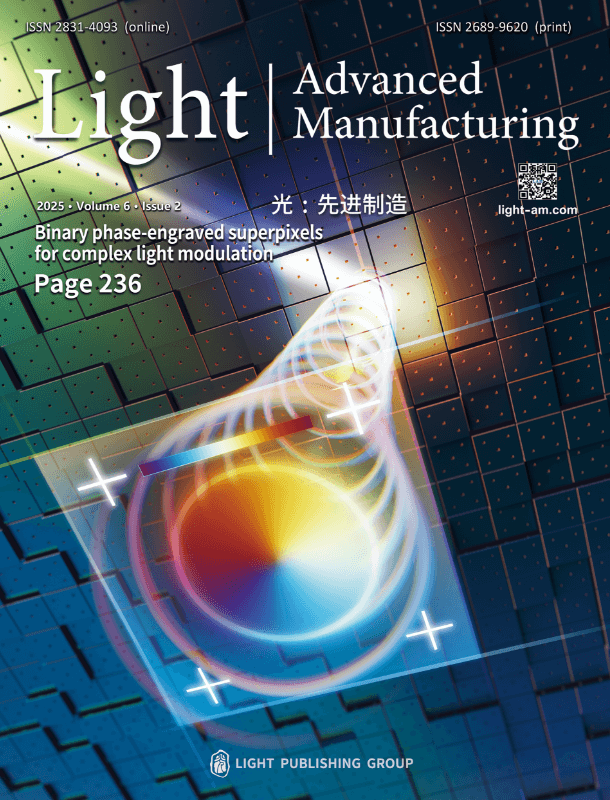-
Optical frequency combs have revolutionised precise spectroscopy, metrology, and imaging1,2. Among comb-based applications, dual-comb spectroscopy (DCS), which uses multiheterodyne beat between two combs with slightly different repetition rates, has emerged as a powerful technique for fast, high-resolution, and moving-part-free spectroscopy2. DCS has been implemented from near-ultraviolet to mid-infrared3,4 and has enabled many important applications, including chemical kinetic diagnostics5, 100-km-scale greenhouse-gas emission monitoring6, and the physio-chemical analysis of supersonic pulsed jets7.
Despite significant progress, DCS still faces challenges in simultaneously realising a broad measurement bandwidth and fast measurement speed. This is because the measurement bandwidth is limited to Δν ≤ fr2/2δfr, where fr is the repetition rate (i.e. the comb line spacing) and δfr is the repetition rate difference between two combs that determines the fastest measurement rate 1/δfr. To achieve this goal, a large comb-line spacing is required; however, an excessively large spacing leads to degraded spectral resolution. Therefore, DCS with a GHz-level repetition rate is of significant interest for balancing measurement speed and spectral resolution8–11. Although dual-microcomb measurements with GHz resolution have been demonstrated4,12, most microcombs usually operate with >10 GHz line spacings. In contrast, most mode-locked lasers have repetition rates below hundreds of MHz. Realizing GHz dual-comb systems remains technically challenging.
Most of the reported mode-locked laser-based DCS systems use two independent lasers5,9. Electronic feedback loops and external references are usually required to maintain their mutual coherence2. The GHz single-cavity dual-comb laser is a compelling alternative for simplifying DCS systems13. Because the two combs share the same cavity, most of the technical noise can be cancelled to enhance the relative stability. Several multiplexing methods, including polarization14, wavelength15, propagation direction16, and spatial dimension17, are feasible for introducing a repetition rate difference between these two pulse trains. Indeed, a polarisation-multiplexed dual-comb laser with a GHz free space cavity has been demonstrated and used in DCS18. However, there are still no reports on GHz single-cavity dual-comb generation in compact all-fibre lasers.
In a recently published paper in Light: Science & Applications, Ling et al. demonstrated wavelength multiplexing in a GHz all-fibre laser with a few-mode gain fibre (FMGF, supporting the LP01 and LP11 mode)19. The dual-wavelength mode-locked laser emits two pulse trains at a rate of 1.093 GHz, with a repetition rate difference δfr = 148 kHz. The repetition rate difference exhibits excellent stability, with an Allan deviation of 101.7 mHz @ 1 s. The short cavity supports the relatively large δfr and 6.75 μs single-frame measurement time, which is the highest for a dual comb emitted from a single fibre laser cavity to date.
Multimode interference (MMI)20 between the FMGF and single-mode fibre (SMF) within the cavity enables dual-wavelength mode locking (Fig. 1). The Fabry-Pérot (FP) laser cavity comprises only one piece of SMF and one piece of FMGF. The unfolded nature of the FP cavity creates an “SMF-FMGF-SMF” structure and results in MMI-based spectral filtering. The frequency spacing of the MMI-based filter can be controlled by the length of the FMGF. Using a relatively large spectral filtering spacing, the soliton trapping effect between the two pulse trains can be broken and dichromatic pulse emission can be attained. Finally, the two pulse trains are spectrally broadened in a photonic crystal fibre to overlap them spectrally for DCS (Fig. 1).

Fig. 1 Schematic of the GHz single-cavity all-fibre dual-comb laser. The multimode interference (MMI)-mediated spectral filtering effect is created within a short cavity formed by a few-mode gain fibre (FMGF) and single-mode fibre (SMF). The cavity emits dichromatic pulses with repetition rates of fr and fr + δfr. By spectrally broadening and overlapping the two pulse trains, the multiheterodyne beat between them can be measured, yielding dual-comb spectroscopy (DCS) with a refresh time below 10 µs.
The robustness and fast measurement capability of the GHz dual-comb laser were carefully examined through outdoor experiments. For example, the team measured the transient wavelength shift of an array of fiber Bragg gratings induced by shockwaves emitted from firecracker explosions. The reliability of the short all-fibre laser cavity and large δfr bode well for deploying the demonstrated GHz dual-comb laser for field measurements. The laser operated at ~1060 nm, but could be transferred to other spectral ranges by nonlinear frequency conversion. By further optimising the laser cavity, both the pulse energy and δfr can improved, which can enable a higher signal-to-noise ratio in DCS and faster measurement rates. This should create exciting opportunities for interdisciplinary applications.
Towards fast spectroscopy using a practical all-fibre GHz dual-comb laser
- Light: Advanced Manufacturing , Article number: (2025)
- Received: 21 April 2025
- Revised: 09 June 2025
- Accepted: 18 June 2025 Published online: 11 August 2025
doi: https://doi.org/10.37188/lam.2025.051
Abstract: A single-cavity all-fibre laser operating at GHz rates is demonstrated as a promising approach for fast spectroscopy. Multimode-interference-based spectral filtering in the laser enables dual-wavelength mode-locked pulse generation (thus, dual-comb emission) with a 148 kHz repetition rate difference. The GHz dual-comb laser exhibits excellent stability and can be used for outdoor measurements.
Rights and permissions
Open Access This article is licensed under a Creative Commons Attribution 4.0 International License, which permits use, sharing, adaptation, distribution and reproduction in any medium or format, as long as you give appropriate credit to the original author(s) and the source, provide a link to the Creative Commons license, and indicate if changes were made. The images or other third party material in this article are included in the article′s Creative Commons license, unless indicated otherwise in a credit line to the material. If material is not included in the article′s Creative Commons license and your intended use is not permitted by statutory regulation or exceeds the permitted use, you will need to obtain permission directly from the copyright holder. To view a copy of this license, visit http://creativecommons.org/licenses/by/4.0/.






 DownLoad:
DownLoad: